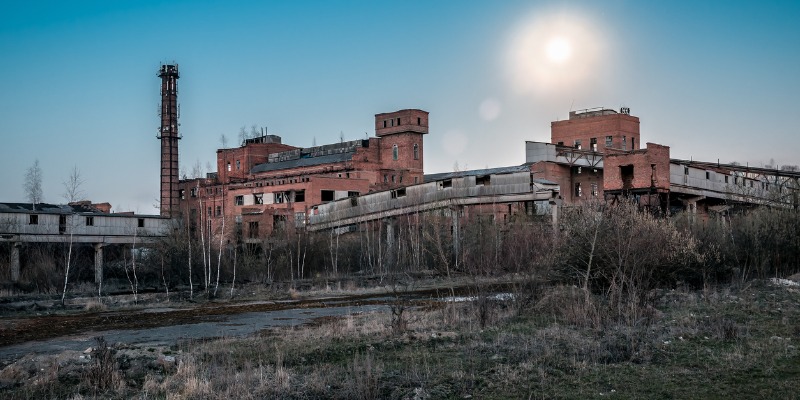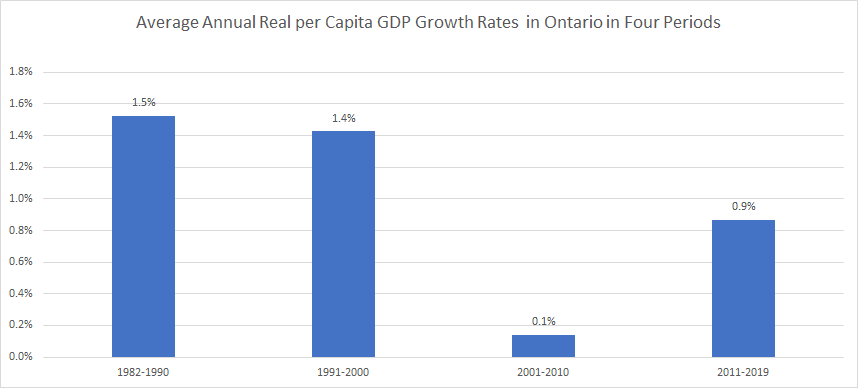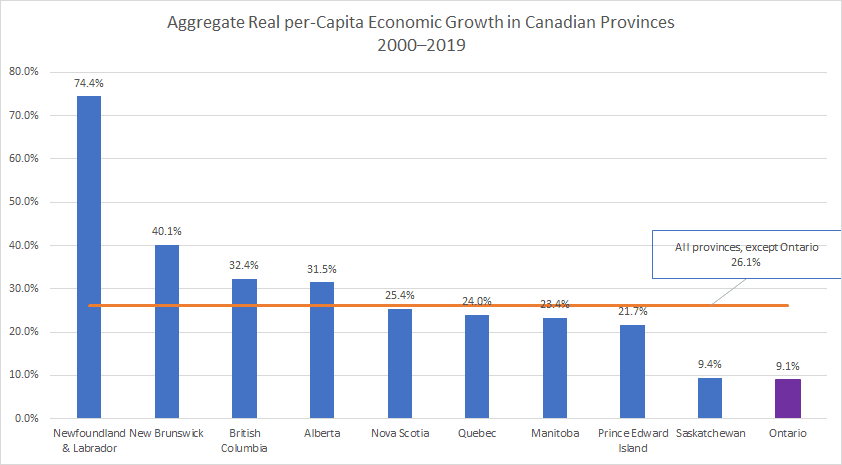Understanding two decades of weak economic performance in Ontario

Ontario was once one of the major engines of economic growth Canada. However, over the past few decades Ontario’s rate of economic growth has been anemic, both in comparison to the province’s own past as well as most other Canadian provinces. Further, there are worrying signs that there may be more challenges for Ontario in the future.
One Fraser Institute analysis described the period immediately before, during, and after the 2008/09 recession as a “lost decade” for Ontario’s economy. Ontario’s economic malaise, however, has been even more long-lived. In fact, since the turn of the century, despite some brief spurts of growth, the province’s economy has been stuck in a lengthy rut.
First let’s consider Ontario’s economic performance previously, as seen in Figure 1.

From 1982 (the first year of available data) to 1990, Ontario’s economy grew at an inflation adjusted rate of 1.5 per cent annually. During the 1990s, the province roughly matched that average annual rate of growth, at 1.4 per cent.
In the new century however, the province slammed the brakes on economic growth. Thanks to an exodus of manufacturing during the 2000s and a sharp recession at the end of the decade, Ontario’s inflation adjusted per-person economic growth in the 2010s was only 0.3 per cent. In other words, there was almost no real economic growth per person at all during that entire decade.
Given the steepness of the 2008-09 recession it would have been reasonable to hope for a strong rebound in the subsequent years. But that’s not what happened. Instead the province saw only a tepid recovery, resulting in another decade of economic growth that was weak in historical terms. The province’s annual average growth rate in the 2010s was 0.9 per cent. That’s better than the preceding decade, but still markedly worse than either the 1980s or 1990s.
It’s fair to point out that globally many jurisdictions have seen only moderate economic growth in recent years. However, comparisons to nearby jurisdictions shows that Ontario’s growth record is especially poor. Figure 2 shows that between 2000 and 2019, Ontario’s cumulative inflation adjusted rate of per person economic growth was only 9.1 per cent. This was the worst performance in Canada, and compares to a rate of 26.1 per cent in all the other provinces taken together.

Meanwhile, another recent study shows that Ontario has also underperformed economically compared to nearby American states. Partly as a result of this weak growth performance in recent decades, Ontario has a lower level of annual economic output than any of its American neighbours that border the Great Lakes.
And Ontario’s dismal growth performance isn’t just a matter of academic concern. It has had a painful impact on the lives of Ontarians. Consider that total private sector job growth in Ontario was just 23.2 per cent from 2000-2019, compared to 31.7 per cent in the rest of Canada.
Making matters worse, in recent years Ontario has struggled to attract business investment. Average annual business investment since 2000-2019 has been lower than any of the other large provinces, and higher than only New Brunswick and Nova Scotia, which have historically struggled to attract investment. Business investment helps create more good high-paying jobs and promotes overall growth. The lack of investment in recent years is therefore a worrying sign for the province’s future economic growth prospects.
The painful reality is that over the past two decades Ontario has experienced weak economic growth performance both compared to its own recent history and the performance of most other Canadian jurisdictions as well as its U.S. neighbours in the Great Lakes region.
It’s important for policymakers to recognize the severity of Ontario’s growth problem, how long-lived it has been, and the challenge of weak business investment that could impede future growth. Grasping the scale of the problem is a first step towards embracing a more pro-growth policy agenda (such as a more competitive and less burdensome tax structure) that can help get the province’s economy growing again and become an engine that helps drive the Canadian economy forward once more.
Author:
Subscribe to the Fraser Institute
Get the latest news from the Fraser Institute on the latest research studies, news and events.

